Optimal Plant Choices for Outdoor Pots
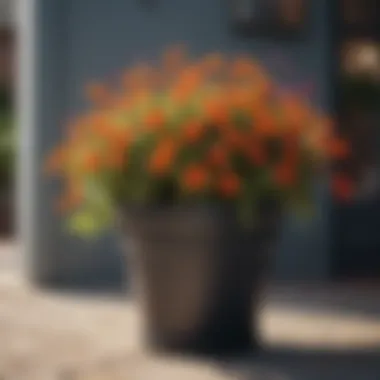
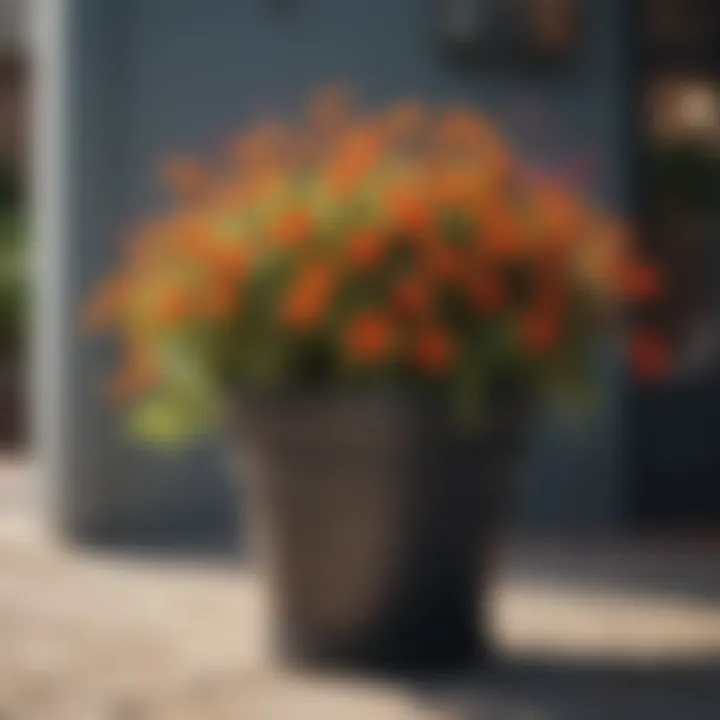
Intro
Choosing the right plants for outdoor pots involves various aspects beyond simple aesthetics. It's about understanding the needs of different species, the conditions in which they thrive, and how they interact with their environment. This article intends to provide a comprehensive guide to make informed plant selections. The focus is not only on enhancing the beauty of outdoor spaces but also ensuring that chosen plants are suitable to the climate and are easy to maintain.
Whether you are a beginner or have some gardening experience, there are common variables that everyone should consider. These include the type of pot you use, sunlight availability, and watering requirements. This guide will also provide insight into how these elements can affect plant health and growth.
Design Inspiration
Current Trends in Outdoor Design
In recent times, the trend of using potted plants has surged. With limited space in urban areas, outdoor pots have become a popular option for adding life and color to balconies, patios, and gardens. Many homeowners now favor minimalistic styles, focusing on clean lines and simple designs.
Textured pots in natural materials like clay, stone, or untreated wood are particularly sought after. These materials blend seamlessly with the environment, providing a rustic charm. On the other hand, sleek metal or glossy ceramic pots cater to a more modern aesthetic, appealing to those interested in contemporary design.
Color Schemes and Palette Ideas
When it comes to color, selecting the right palette can make a substantial difference in your outdoor space. Earthy tones like terracotta or natural greens work well with various plant colors and textures. White and pastel colors can provide a fresh and soothing look.
It's also vital to consider seasonal changes. Some plants bloom brightly in spring and summer, while others may provide subtler hues in fall and winter. Balancing these colors creates visual interest throughout the year.
"A unified color scheme merges the plant's hues with the pot’s tones, creating harmony in your outdoor space."
Gardening Techniques
Plant Selection and Care
Selecting plants suited for pots involves understanding their growth habits and care requirements. Many people tend to choose plants based on appearance alone. However, factors such as root space, light needs, and moisture levels must be considered for long-lasting results.
Here are a few recommended plants for outdoor pots:
- Succulents: Low-maintenance and drought-resistant, they thrive in well-draining soil and bright light.
- Herbs: Varieties like basil, rosemary, and mint not only enhance the aesthetic but offer culinary benefits as well.
- Annuals: Flowers such as petunias and marigolds add vibrant color and require regular deadheading for optimal blooming.
Indoor vs. Outdoor Gardening
While this guide focuses on outdoor pots, many gardeners might inquire about indoor gardening. There is a clear distinction between the two. Whereas outdoor pots face elements from nature, indoor pots are often sheltered and may require different care strategies.
Outdoor plants need to be selected based on their resistance to weather changes, while indoor plants benefit from controlled conditions. This is why understanding the environment is critical in making the right choices.
The key to a successful gardening experience lies in being aware of these differences and adopting the right techniques. With improved understanding, homeowners can elevate their outdoor spaces using pots effectively, showcasing the beauty of the plants while ensuring their longevity.
Foreword to Outdoor Pot Plants
Understanding the Importance of Container Gardening
Container gardening allows individuals to cultivate plants without the need for traditional garden beds. This flexibility is especially advantageous in urban settings where space is often at a premium. By using pots, gardeners can manipulate the environment to suit their preferences. For example, plants can be moved depending on light requirements, making it easier to keep them healthy.
Furthermore, container gardening can introduce variety. Plants that typically do not thrive in particular climates can flourish in controlled pot environments with regulated watering and soil conditions. This method encourages experimentation with diverse plant types that may not be suitable for in-ground planting.
Benefits of Using Pots for Outdoor Plants
There are several clear benefits of using pots for outdoor plants:
- Mobility: Pots can easily be relocated, allowing plants to receive optimal sunlight or shelter from harsh weather conditions.
- Soil Control: Using specific potting mixes lets gardeners create ideal soil conditions tailored for each plant type. This prevents issues like poor drainage, compaction, or nutrient deficiency.
- Reduced Weeds and Pests: Container plants are less susceptible to weeds and specific soil pests, leading to healthier plants overall.
- Aesthetic Appeal: Outdoor pots can enhance the visual aspects of a space. With various shapes, colors, and sizes, they serve as design elements in landscaping.
- Extended Growing Season: Pots can retain heat better than the ground, providing a microclimate that may allow plants to thrive longer into colder months.
Container gardening stands as a versatile method that caters to both novice and experienced gardeners, enabling creativity while addressing practical gardening challenges.
In summary, understanding the fundamentals of outdoor pot plants deepens the knowledge of gardening enthusiasts and homeowners. This knowledge can lead to smarter choices in both plant selection and overall garden management, ultimately resulting in a richer gardening experience.
Choosing the Right Plants
Selecting suitable plants for outdoor pots is vital. A well-chosen plant can enhance the aesthetic appeal of a space, while also thriving in a container setting. Careful selection considers factors such as growth patterns, maintenance, and climate adaptability. This section will explore essential considerations that can guide homeowners and gardening enthusiasts in making informed plant choices.
Considerations for Plant Selection
Climate conditions
Understanding climate conditions is crucial when choosing plants for outdoor pots. Different plants have varying tolerance to heat, cold, and humidity levels. For instance, tropical plants often prefer warm, humid environments, while succulents thrive in dry, arid conditions. Selecting plants that are well-suited to the local climate is not only beneficial for the plants’ growth but also contributes to water conservation and reduced maintenance.
The unique feature of climate conditions is that it affects plant growth cycles. Some plants bloom in spring, while others may only flourish in summer. This specificity allows gardeners to create arrangements that can offer visual interest throughout the seasons. However, planting species that are not adaptable to the local climate could result in poor growth or even plant death, underscoring the importance of this consideration.
Sunlight requirements
Sunlight requirements play a significant role in the successful growth of potted plants. Different plants require different amounts of sunlight, which can range from full sun to partial shade. For example, flowering plants like Petunias need full sun, while ferns prefer cooler, shaded areas. Understanding these requirements helps in selecting the right plants for specific locations and aspects of a garden or patio.
A key characteristic of sunlight requirements is their influence on the photosynthesis process. Plants that receive adequate sunlight will have better growth and more vibrant blooms. Choosing the appropriate plants based on their sunlight needs helps avoid issues such as leggy growth and poor flowering. It is therefore vital to assess available sunlight in each planting spot before making choices.
Soil types
Soil types significantly impact the growth outcome of potted plants. Different plants have specific soil preferences that affect their water retention and nutrient availability. For instance, succulents do best in well-draining sandy soils, while ferns prefer soils that retain moisture. Understanding these needs can help in providing optimal conditions for plant health and vigor.
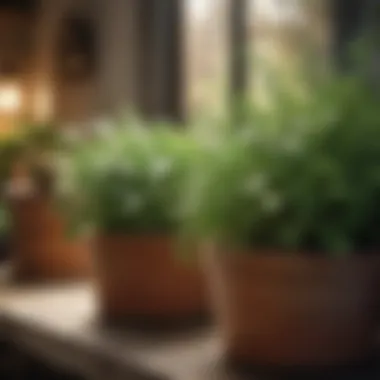

The unique aspect of soil types is the creation of tailored potting mixes that can enhance plant performance. A good mix for flowering plants might include compost, peat, and perlite to ensure adequate drainage and nutrient supply. On the other hand, certain native plants might thrive in heavier, clay-like soils. Ignoring soil requirements can lead to challenges such as root rot or nutrient deficiency, making this consideration crucial for successful container gardening.
Native vs. Exotic Plants
When selecting plants, a key decision revolves around native versus exotic species. Native plants are those that naturally occur in one’s local area, while exotic plants are non-native species brought in from other regions. Choosing between these two categories involves weighing their respective benefits and drawbacks. Native plants often boast a higher resilience to local pests and diseases. They typically require less maintenance and water as they are adapted to the local environment. Exotic plants, on the other hand, can introduce diverse colors and forms to a garden but may require careful consideration to ensure they will thrive in the local climate and soil.
Ultimately, understanding the differences between these two choices equips gardeners with the insight needed to enhance their outdoor spaces, aligning aesthetics with practical considerations.
Popular Plants for Outdoor Pots
Choosing the right plants for outdoor pots is vital in container gardening. The selection of plants not only enhances the visual appeal of outdoor spaces but also involves considerations of growth habits and maintenance. It is essential to understand the needs of the chosen plants to ensure thriving results.
The variety of plants suitable for containers ranges from vibrant flowering plants to useful herbs. Each category offers unique benefits and can suit various styles and preferences in gardening. These choices play an important role in maximizing the potential of limited spaces, providing color, texture, and even food.
Flowering Plants
Petunias
The Petunia is a standout in the realm of container gardening. Its capability to produce an abundance of colorful blooms, from vibrant reds to gentle pastels, allows for versatile combinations in pots. Petunias are often regarded for their extended blooming period, which can last most of the growing season with proper care. This characteristic makes them a favorite among gardeners aiming to bring life to patios and balconies.
However, Petunias do require regular deadheading to maintain their appearance and encourage continuous flowering. They thrive best in sunny locations, needing at least six hours of sunlight each day. This may limit placement options, particularly in shadier gardens.
Marigolds
Marigolds provide not only visual appeal but also practical benefits in the garden. These plants are known for their vibrant yellow, orange, and red hues, which can brighten up any outdoor area. A key feature of Marigolds is their ability to deter certain pests, making them an effective companion plant in edible gardens or herb pots.
Though Marigolds are relatively easy to grow, they require consistent watering to ensure they do not dry out. This can be a minor drawback in very hot climates where pots can dry quickly, requiring attention.
Geraniums
Geraniums are also a popular choice for outdoor pots. Their rich colors and distinctive leaves can add depth and character to containers. Known for their long-lasting blooms, Geraniums often perform well in sunny locations and can tolerate various weather conditions. Another benefit is that these plants are relatively low maintenance, allowing less frequent need for watering compared to other flowering options.
However, they can be susceptible to certain fungal diseases if the soil does not drain well. Ensuring that pots have adequate drainage holes is crucial in maintaining the health of Geraniums.
Foliage Plants
Ferns
Ferns bring lush greenery and texture to outdoor pots, making them an excellent choice for shaded areas. With their delicate fronds, ferns can create a tranquil and inviting presence in gardens. Their unique aesthetic contributes to dynamic arrangements alongside brighter flowers.
These plants usually thrive in moist soil and require careful attention to water levels. Ferns can struggle in direct sunlight, which may reduce their leafy vigor.
Hostas
Hostas are another exceptional choice for foliar display. These plants come in a variety of sizes and shades of green, often with striking white or yellow margins. Their ability to thrive in shaded areas makes them suitable for areas with limited sunlight.
One consideration with Hostas is their preference for moist, well-drained soil. Overwatering can lead to root rot, making careful management necessary.
Caladiums
Caladiums stand out due to their colorful leaves, coming in shades of pink, white, and green. This stunning foliage has the ability to transform any pot into an instant focal point. The unique shapes and patterns of the leaves contribute to varied design ideas and arrangements.
However, Caladiums are sensitive to cold temperatures and thrive in warm climates. They may not be suitable in areas with harsh winters unless brought indoors.
Herbs and Edibles
Basil
Basil is a versatile herb, popular for its culinary uses. It grows well in pots, allowing for easy access during meal preparation. This plant thrives in sunny locations, requiring at least six hours of sunlight daily, and needs a well-draining potting mix.
While maintaining Basil is relatively easy, it does require regular harvesting to encourage bushy growth. This can benefit the overall yield, making it an advantageous choice for gardeners seeking to enhance their cooking.
Thyme
Thyme is another herb that adapts well to container gardening. Known for its fragrant leaves, it adds unique flavor to dishes. Thyme is relatively low-maintenance and prefers dry conditions, reducing the frequency of watering. This aspect makes it suitable for those in warmer regions.
Despite its hardiness, excessive moisture can lead to root rot. Ensuring that Thyme is planted in pots with adequate drainage is essential.
Tomatoes
When it comes to edible plants, Tomatoes are a widely favored choice. Compact varieties specifically bred for pots can yield a bountiful harvest. They require sufficient sunlight, needing at least six to eight hours of exposure, and care should be taken with watering to maintain consistent moisture without oversaturation.
Tomatoes can be more labor-intensive due to the need for supports as they grow. Still, the benefits of homegrown tomatoes in the kitchen make it a rewarding endeavor.
Succulents and Cacti
Aloe Vera
- Aloe Vera* stands out due to its multifaceted nature. It serves as both a decorative element and a wellness product, as its gel is famed for its soothing properties on skin irritations. These plants are suitable for dry climates and require very little water, making them ideal for novice gardeners.
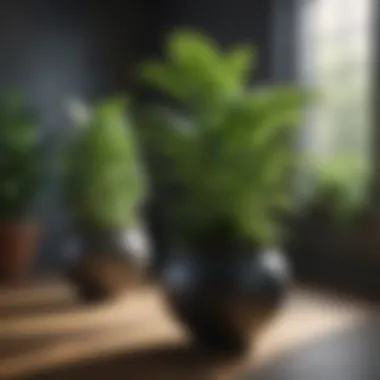
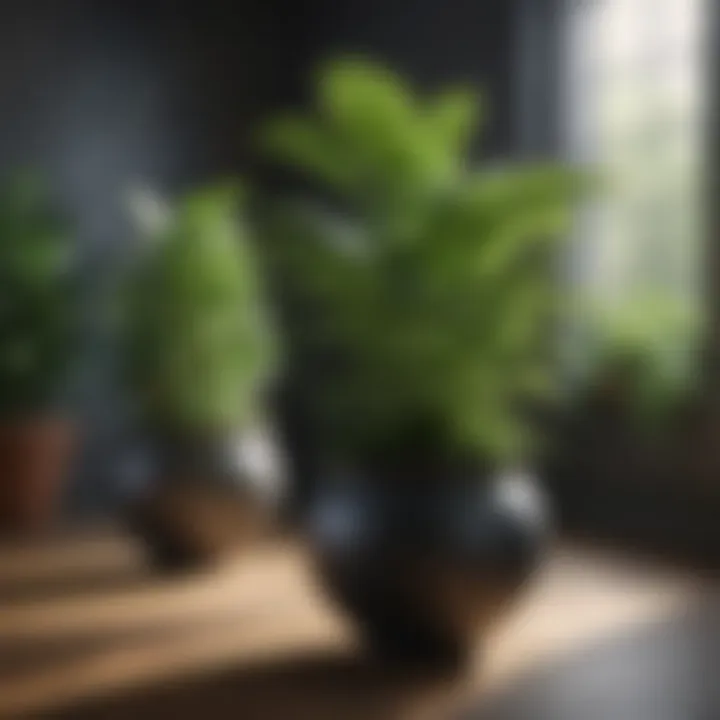
However, Aloe Vera should be protected from frost. It requires a potting mix that drains well to prevent roots from rotting.
Sedum
Sedum encompasses a variety of succulents known for their resilience and ability to thrive in poor soil. These plants can produce clusters of flowers, adding aesthetic value to outdoor spaces. Their sprouting nature makes them good for ground cover while working well in pots.
Though low maintenance, Sedum requires bright sunlight, which is essential for their health.
Echeveria
Echeveria are rosette-shaped succulents known for their symmetry and varying colors. They require relatively low care, thriving under similar conditions as other succulents. Excellent drainage is essential, and they enjoy bright light.
One drawback to consider is that Echeveria can be sensitive to overwatering and cold conditions, necessitating proper care for long-term success.
In summary, selecting suitable plants for outdoor pots can significantly enhance the aesthetics and function of garden spaces. Understanding the unique features and requirements of each category allows gardeners to create harmonious arrangements that fit their needs.
Container Selection and Requirements
Selecting the appropriate container is crucial for the success of plants grown in pots. Containers not only provide physical support but also influence the growth, health, and visual appeal of the plants inside them. Attention to various attributes of pots helps in creating an environment suitable for the chosen plants. Choosing the right pot can improve drainage, support plant roots, and enhance aesthetic qualities in gardens or balconies. Each type of container has unique characteristics that can affect plant care and overall gardening experience.
Types of Pots and Their Attributes
Material considerations
Material of pots significantly affects plant growth. Materials like terracotta, plastic, and ceramic each have distinct properties. Terracotta pots provide good aeration due to their porous nature, allowing roots to breathe. However, they can dry out quickly. Plastic pots, on the other hand, retain moisture better and are lighter, making them easier to move. They are also available in varied colors, which can enhance the look of any outdoor space. Ceramic, while visually appealing, can be heavy and may need more careful handling.
It is essential to consider these factors when selecting pots. Choose material based on the plant type and specific needs. If you have plants that prefer stable moisture levels, plastic might be your best option.
Size and drainage
The size of the pot is another critical factor. A pot that is too small can inhibit roots from growing, leading to stunted plant development. Conversely, large pots may retain excess moisture, leading to root rot. A general rule of thumb is to select a pot that allows for at least a couple of inches of space around the roots.
Drainage holes are a must for any outdoor pot. They allow excess water to escape, preventing overwatering and promoting healthier root systems. A pot without proper drainage may drown the plants, leading to a host of issues down the line.
Weight and stability
Weight and stability are fundamental aspects when selecting pots, especially for larger plants or outdoor settings. A heavy pot provides stability and reduces the likelihood of tipping over in strong winds. This is particularly important in open areas where gusts could displace your precious arrangements. Lightweight materials may be easier to manage during plant shifts or seasonal changes. However, you must balance this with the risk of instability.
Choose pots that match both the size of the plants and the expected weather conditions. Over time, finding the right balance between weight and mobility will ensure that your plants stay well-supported and healthy.
Importance of Drainage
Proper drainage is vital for healthy plant growth. It prevents the roots from sitting in water and reduces the likelihood of diseases like root rot. Selecting pots that allow for adequate water release ensures better root health and strong plant growth.
Strong drainage practices should be in place, regardless of pot materials or sizes. Consider using potting mixes designed to improve drainage. Regularly check drainage holes to keep them from being blocked, particularly during the rainy season.
In summary, the choice of containers is critical in creating thriving outdoor plants. Evaluate materials, sizes, and drainage options with each plant in mind to ensure longevity and health.
Soil and Fertilization Needs
The foundation of any successful outdoor pot garden lies in understanding soil and fertilization needs. Soil quality directly affects plant health, growth, and overall vigor. Using the right type of soil can improve drainage, retain moisture, and provide essential nutrients. Furthermore, the appropriate fertilization techniques ensure that plants receive the nourishment required for optimal development. This section delves into how to choose a suitable potting mix and the best fertilization methods to employ.
Choosing the Right Potting Mix
Selecting an appropriate potting mix is crucial for potted plants. Unlike garden soil, which may compact and restrict growth, potting mixes are designed to promote aeration and drainage. A good potting mix should contain a balance of organic materials, such as peat moss or coconut coir, along with perlite or vermiculite for aeration. Additionally, it must have the right pH level suitable for the plants you intend to grow.
Consider the following factors when choosing your potting mix:
- Type of Plants: Different plants have varying soil requirements. For instance, succulents prefer well-draining soil, while ferns thrive in moist conditions.
- Moisture Retention: The mix must retain enough moisture without becoming waterlogged.
- Nutrient Content: Some mix variations come pre-fertilized. This feature can benefit beginners who might not yet be familiar with fertilization schedules.
Ultimately, a high-quality potting mix will support healthy root development and contribute to vibrant foliage and blooms.
Fertilization Techniques
Fertilizing potted plants is essential to replenish nutrients that naturally deplete over time. The technique of fertilization can vary depending on the plant type and the season. Here are some effective strategies:
- Liquid Fertilizers: These are easily absorbed by plants and can be mixed with watering routines. Applying a balanced liquid fertilizer during the growing season helps meet the nutrient demands of plants.
- Slow-Release Granular Fertilizers: These granules dissolve gradually, providing nutrients over an extended period. This method reduces the frequency of fertilization but may require monitoring to ensure the soil does not become nutrient-saturated.
- Organic Options: Compost and worm castings are excellent organic fertilizers that can enhance soil quality while promoting beneficial microbial activity.
Regular monitoring of plants will guide you on when to fertilize and at what strength. Adjust based on their appearance and growth patterns.
"Regularly check potted plants for signs of nutrient deficiency, such as yellowing leaves or poor growth."
In summary, understanding soil and fertilization needs is fundamental for those engaged in container gardening. Proper selection of potting mix and effective fertilization techniques will ensure the success and longevity of your outdoor potted plants.
Watering Practices for Potted Plants
Watering practices are critical when managing potted plants. The unique conditions of container gardening affect how soil retains moisture and how plants access nutrients. Therefore, understanding proper watering techniques can make the distinction between flourishing plants and wilted ones. When plants are in pots, they can experience different moisture levels than those grown in the ground. The growth and longevity of plants in containers largely depend on effective watering strategies.
Establishing a Watering Routine
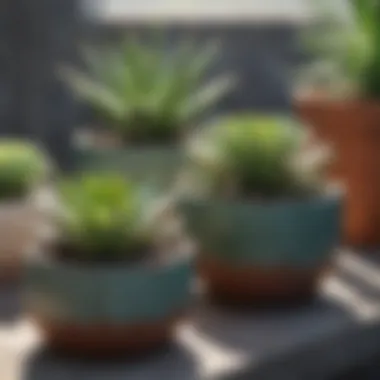
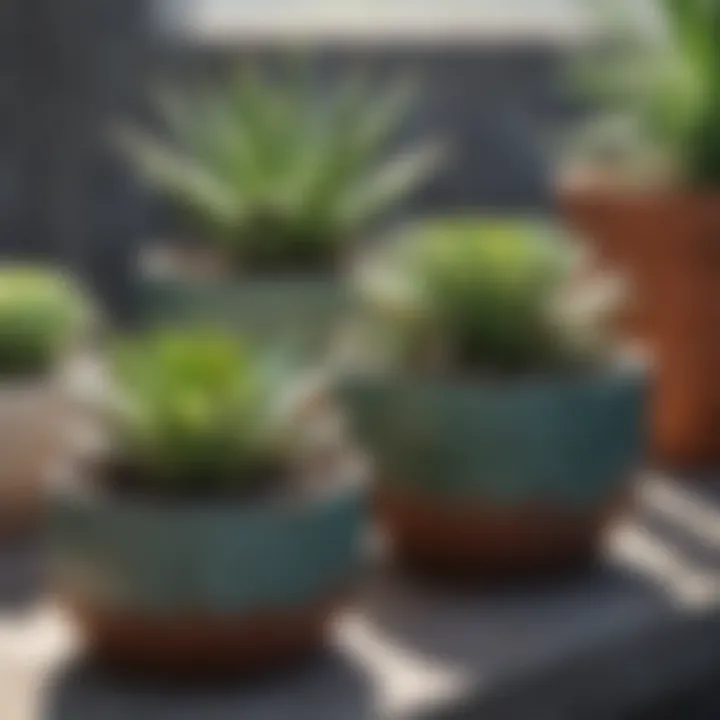
A consistent watering routine is essential for potted plants. It helps to keep a stable moisture level in the soil. Different factors can influence how often you should water. This includes plant types, pot sizes, and climate conditions. Here are some important points to consider when establishing a watering schedule:
- Types of Plants: Some plants, like succulents, require less frequent watering compared to tropical varieties, which might need more.
- Seasonal Changes: Understand that during hotter months, evaporation increases. This may necessitate more regular watering compared to cooler months.
- Check Soil Moisture: Before watering, check the top inch of the soil. If it feels dry, it's time to water. Monitor the moisture levels regularly to adjust your routine.
By developing a routine, you can avoid over- or under-watering. Staying consistent is key.
Identifying Water Needs
Every plant has unique water needs. Identifying these requirements is crucial for their health. Observing the plant's behavior can give clues about its hydration levels. Here are some factors to consider when assessing water needs:
- Leaf Condition: Check for wilting or browning edges. These can indicate both overwatering and underwatering.
- Growth Rate: If your plant is growing slowly, it may not be getting enough water. Conversely, rotting roots might suggest too much water.
- Soil Type: Different soil mixes retain moisture differently. Quick-draining soils require more frequent watering. In contrast, dense mixes hold water longer.
"Understanding how to properly water potted plants ensures they thrive and remain visually appealing in your outdoor spaces."
By paying attention to these signs and adjusting your habits, you can foster a healthier environment for your potted plants. Using these practices will lead to a more vibrant outdoor area, enhancing your overall gardening experience.
Seasonal Care for Outdoor Pots
Seasonal care is crucial for maintaining the health and aesthetics of your outdoor potted plants. Each season presents unique challenges and opportunities that can affect plant growth, blooming cycles, and overall vitality. Knowing how to prepare for and respond to seasonal changes ensures that your plants thrive throughout the year. Failing to consider seasonal needs could result in poor plant performance, wasted resources, and a less appealing outdoor space.
Understanding the nuances of seasonal care can advance your gardening skills. It allows you to adapt to changing weather conditions, soil requirements, and pest management. Seasonal monitoring and adjustments lead to lush growth, vibrant colors, and hearty plants in your outdoor pots. Below, key aspects of seasonal care unfold, highlighting their importance in successful container gardening.
Spring Preparation
Spring marks the awakening of plants after dormancy during winter. For outdoor pots, this is a critical time for preparation. Start by assessing the health of both plants and containers. Determine if any plants survived the winter or if replacement is necessary. This might involve refreshing the soil or replacing dead plants with new ones.
During spring, focus on these specific tasks:
- Clean the pots: Remove debris, fallen leaves, and any dead plant material.
- Inspect drainage holes: Ensure that they are free from blockages to prevent root rot.
- Add fresh potting mix: This recharges nutrients and improves soil structure.
- Fertilization: Applying balanced fertilizers is essential to kickstart growth and flowering.
- Selecting new plants: Choose varieties that thrive in your climate, taking into account sun and shade preferences.
Making these preparations sets a strong foundation for your plants to grow and flourish.
Summer Maintenance
As summer progresses, care for your outdoor pots must become more frequent and attentive. The high temperatures and sunlight directly impact soil moisture and plant health. Optimal summer maintenance includes:
- Watering regularly: Monitor pot moisture closely, watering as needed. The heat of the summer sun increases evaporation rates.
- Mulching: Adding a layer of mulch helps retain soil moisture and regulates temperature.
- Pruning: Trim back any overgrown or dead foliage to encourage new growth and prevent diseases.
- Monitoring pests: Keep an eye out for common pests like aphids or spider mites, which may thrive in warm conditions. Early intervention can prevent infestations.
- Fertilizing again: Use a fertilizer designed for the specific types of plants you are growing, as their nutrient needs can increase in summer.
Regular maintenance not only supports growth but also enhances the visual appeal of your potted plants, contributing to a vibrant outdoor environment.
Fall and Winter Care
As fall transitions into winter, it is crucial to adjust your care practices. The approach focuses on protection and preparation for dormancy. Understanding your region's frost dates and winter conditions will guide these actions. Consider the following practices:
- Reduce watering: As temperatures drop, plants require less water. Overwatering can lead to root rot in colder months.
- Winterization of pots: For areas prone to freezing temperatures, consider moving pots to sheltered locations or wrapping them to insulate against cold.
- Pruning perennials: After the growing season concludes, prune back perennial plants to prevent damage and encourage growth in the spring.
- Checking for pests: Unfortunately, pests may seek shelter within pots during winter. Regular inspections can help identify and eliminate them.
- Plan for spring: Use this time for reflection on plant choices and to research new varieties you might want to try once the warmth returns.
Ultimately, effective seasonal care of your outdoor pots requires being proactive about the unique needs of your plants. Through diligent care, you transform each season into an opportunity for beauty, health, and enjoyment in your outdoor spaces.
Pest Management and Health Monitoring
Pest management and health monitoring are crucial aspects of maintaining vibrant and healthy outdoor pot plants. Ignoring these factors can lead to diminished plant health and aesthetic appeal. Pests can quickly become overwhelming, so identifying and managing them early is vital. Moreover, monitoring the overall health of plants allows gardeners to take preventative measures that enhance resilience against challenges.
Understanding how pests affect potted plants involves recognizing their behavior and signs of infestation. Regular inspection helps in early identification of problems, further supporting the growth and longevity of outdoor plants.
Common Pests in Outdoor Pot Plants
Various pests frequently attack outdoor potted plants. Some of the most common include:
- Aphids: Small, often green, these bugs feed on sap and can stunt growth. They reproduce quickly, making them a high-priority target for management.
- Spider mites: These tiny arachnids create webbing and feed on plant juices. They thrive in hot, dry conditions, leading to leaf discoloration.
- Whiteflies: Similar to tiny moths, whiteflies cling to the undersides of leaves. Their feeding leaves plants weakened and susceptible to diseases.
- Mealybugs: Covered in a cotton-like substance, they feed on the stem and leaves, which can lead to wilting and stunted growth.
Regularly checking for these pests and understanding their life cycles helps to reduce their impact on your greenery.
Preventative Measures
Taking a proactive approach to pest management can save a lot of hassle. Here are effective preventive measures to combat pests:
- Correct Plant Placement: Ensure that pots are positioned wisely to maximize sunlight exposure, making it harder for pests to thrive.
- Regular Inspections: Check the plants weekly for any signs of pests. Early detection is key to their management.
- Cleanliness: Keep the area around your pots clean from debris and fallen leaves. This reduces hiding places for pests.
- Use Natural Predators: Introducing beneficial insects, like ladybugs, can help control pest populations without chemical intervention.
- Companion Planting: Some plants can deter pests when planted nearby; for instance, marigolds naturally repel certain insects.
- Proper Irrigation: Avoid overwatering as it can lead to root rot, attracting pests. Always check for water drainage and maintain good humidity.
Regular pest monitoring and preventative measures yield not just healthy plants, but a more beautiful outdoor space overall.
Incorporating these strategies into your gardening regimen enhances not only the health of your outdoor pots but also instills a sense of accomplishment in your gardening efforts. Keeping a close watch on plant health and being vigilant about common pests ensures that your plants can flourish throughout their seasons.
Culmination
Furthermore, optimal plant choices can enrich the environment, providing ecological benefits. Selecting native species, for instance, can promote local biodiversity while requiring less maintenance and water compared to non-natives. This means more time enjoying the garden and less time managing it.
In addition, understanding the unique needs of each type of plant can facilitate better care routines. For example, herbs need regular harvesting for optimum growth, while succulents may prefer less frequent watering. Recognizing these specifics helps maintain a healthy garden that can thrive in outdoor pots.
In essence, thoughtful plant selection contributes to an engaging outdoor experience that reflects individual style and enhances property value.
Final Considerations
As you contemplate your final choices for outdoor pots, keep in mind the synergy between plants, pots, and their environment. The size and type of pot will affect drainage, while the plant species will dictate care frequency and light requirements.
Here are a few final tips to consider:
- Evaluate Outdoor Conditions: Observe the sunlight, wind patterns, and rainfall in your garden. These elements significantly influence plant health.
- Mix and Match: Combining different types of plants, such as flowering and foliage species, can create a dynamic and visually interesting layout.
- Practicality Over Aesthetics: While beautiful arrangements are appealing, ensure that they are also functional, considering how easy it is to maintain.
- Stay Educated: Gardening is a constantly evolving field. Regularly update your knowledge about new species and best practices to keep your outdoor pots thriving.



